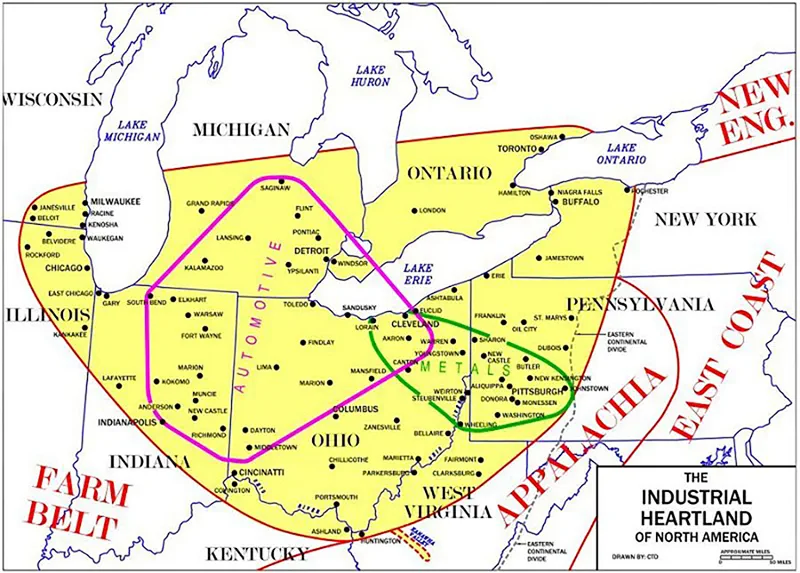Quote:
Originally Posted by eschaton

I understand the point you're making, but economic links do not equal cultural links.
To give an example, look at NYC. The reason the city leapt past Philly and Boston to become the largest U.S. metropolis by far was the Erie Canal, which meant that the final domestic port for the whole of the U.S. Great Lakes was at the mouth of the Hudson. This did not create cultural links between the Great Lakes and NYC though. It did link the Great Lakes with New England, but NYC's cultural influence was not felt north of Albany.
A bit later on, NYC's economy was tightly linked with the U.S. South, with cotton coming up in raw form, and made into clothing for international and domestic markets. The linkage was strong enough to affect politics, making NYC have Confederate leanings during the Civil War. However, it did not make NYC culturally southern.
Pittsburgh pretty much always "looked east" towards NYC and Philadelphia. It never really associated culturally with Cleveland beyond sports rivalry and the like.
The things that make a city feel distinct are aspects like the built environment, the local accents, the cultural traditions, etc. That's why somewhere like New Orleans is considered to have such a strong "sense of place" compared to the rest of the Southeast. There's simply not a lot that Pittsburgh shares with the Great Lakes region of the U.S. by these metrics.
|
I think we're talking about different things.
Though, first off, NYC is much further from the Great Lakes than is Pittsburgh, and much more importantly, NYC is MUCH further from the industrial hub of Great Lakes cities -- whereas Pittsburgh is actually a vital part of that hub. Additionally, with the Erie Canal, we're talking the early half of the 1800s when Great Lakes cities barely even existed... so no, we're not going to see a lot of NYC "cultural connection" with the Great Lakes cities of today.
I'm not talking about architectural styles or regional accents. But if I was, I would talk about how Pittsburgh's style and accent emanates from southeastern PA and Maryland... and not from St. Louis or Louisville. And I've never once listened to someone in St. Louis or Louisville speak and been transported by the sound of their accent to a shot & beer bar in McKees Rocks or Sharpsburg or the South Side.

If we are simply talking about urban typology, then sure, we can be very simplistic about it and say river city or lakes city and be done with it. As I've said, even though Pittsburgh is certainly
not a Great Lakes city, it is more closely connected with Great Lakes cities than it is with the other River cities, regardless of whether its housing vernacular and river valley location make it look much more like Cincinnati. So if I were to put Pittsburgh in one of these two groups...
Buffalo
Cleveland
Detroit
or
Cincinnati
Louisville
St. Louis
... there is zero doubt to me that it belongs in the top list. Does anyone really think that in the national consciousness that the name and ethos of "Pittsburgh" fits more appropriately in that bottom list? Come on!
To your first assertion that
"economic links do not equal cultural links", they might not equal each other, but tight economic connection forged via various industries (that is, what people in a region do for work for literal generations of life) for over a century most certainly do play a big role in forming a shared culture.
To claim that cultural connection doesn't arise from the below would be absurd:


The shared heavy manufacturing heritage, and all of the historical, economic, ethnic connection between Cleveland/eastern OH & Pittsburgh/western PA that comes with it, gave us football as we know it today, for chrissakes.

It's no accident that western PA and eastern OH is the veritable cradle of American football... and if football is not a "cultural link" in this country, then I don't know what the heck is. But aside from football for now, you don't believe that Pittsburgh has shared "cultural traditions" with Cleveland, considering that they have basically the same European ethnic makeup from the same era?
To the second point about how
"Pittsburgh pretty much always "looked east" towards NYC and Philadelphia. It never really associated culturally with Cleveland beyond sports rivalry and the like."... well, if Pittsburgh does look east, then why would Pittsburgh be culturally connected with points much further west than Cleveland -- like Cincinnati, Louisville, and St. Louis?
A longtime sports rivalry and the like (i.e., Browns and Steelers) just derives from a history of regional/cultural association and similar situation/purpose... just like a high school sports rivalry exists between adjacent towns/neighborhoods... it comes from familiarity. Not because brick rowhouses 550 miles away in St. Louis looks like the brick rowhouses in Pittsburgh.
And the rivalry predates the Steelers and Browns... and likely predates Carnegie vs. Rockefeller. The rivalry goes back to when poor miners and mill workers from eastern OH and western PA were kicking and scratching for the same thing in the same area... and intermixing heavily. That's shared culture!



